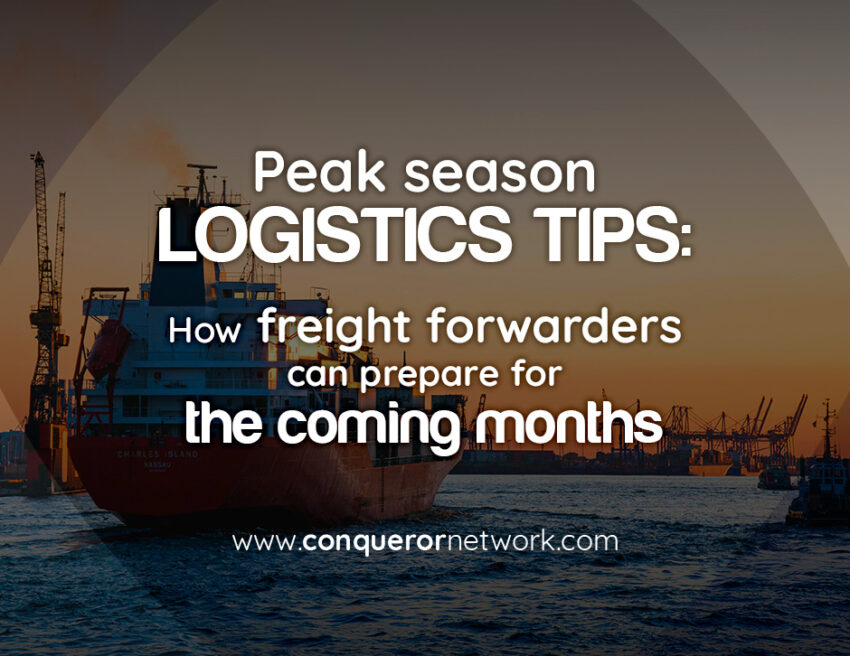It’s late September, which means the countdown to peak shipping season has officially started. For freight forwarders, this period isn’t just about moving more cargo, it’s about handling chaos without losing control. The last quarter of the year brings surging demand, tighter capacity, and sky-high freight rates, making it the most stressful (and potentially most profitable) time on the logistics calendar.
So how do you keep your operations running smoothly when the pressure’s on? Here are peak season logistics tips to help you stay ready, resilient, and ahead of the competition.

Understanding the 2025 peak season challenges
Every year comes with its own headaches, but 2025 brings a few new twists that freight forwarders need to watch:
-
Capacity crunches will hit harder and earlier. Ocean carriers are already signaling possible rollovers due to port congestion in Asia and Europe. Air freight capacity will tighten as e-commerce giants compete for space.
-
Freight rates are volatile. With geopolitical tensions affecting major shipping lanes and Panama Canal transit delays still an issue, rates could spike unexpectedly.
-
Longer lead times and slower customs clearance. As cargo volumes rise, customs bottlenecks are inevitable, especially at high-volume ports.
-
Equipment shortages. Empty container imbalances could become a real pain point, particularly on Asia–Europe and Transpacific routes.
-
Pressure from shippers. Clients will expect miracles such as last-minute bookings, guaranteed space, and clear communication and they’ll expect it all at competitive rates.
The goal isn’t just to survive these challenges but to turn them into opportunities to build stronger relationships and deliver real value.
Peak season logistics tips: Plan early, act fast
The number one rule for navigating peak season successfully? Start early. Here’s how to build a proactive strategy:
-
Secure space now. Negotiate with carriers early and lock in capacity before rates skyrocket. If you have consistent shippers, get their volume forecasts and book as much in advance as possible.
-
Diversify your routes. Don’t put all your cargo on one lane. Explore alternate ports, intermodal solutions, and less obvious shipping routes to avoid bottlenecks.
-
Offer flexible solutions. Partial shipments, split routings, or LCL options can help clients keep inventory moving even when space is tight.
-
Use digital tools for visibility. Invest in real-time tracking and automated updates so you can quickly respond to disruptions and keep customers informed.
- Work closely with your trusted partners, including your Conqueror Freight Network connections, to make this peak season your most successful yet.
Keep communication tight, especially with your network partners
No freight forwarder is an island, especially during peak season. One of the smartest peak season logistics tips is to strengthen collaboration with your partners. If you’re a Conqueror Freight Network member, this is the perfect time to lean on your network connections.
Reach out to your partners in key markets now, confirm their handling capacity, and share your forecasted needs. Clear communication helps avoid misunderstandings when time is short and stress levels are high. By coordinating early, you can secure warehouse space, inland transport, and customs brokerage services before everyone else starts scrambling.
This is also a good time to discuss contingency plans. If one partner’s main port gets congested, can they redirect shipments to a secondary port? If air capacity dries up, do they have reliable trucking partners for cross-border solutions? The more you coordinate now, the smoother your operations will be when volumes spike.
Optimize your internal operations
Peak season magnifies inefficiencies, so small problems can snowball into crises. Take the time in late September and early October to:
-
Streamline workflows. Eliminate unnecessary manual processes where you can. Automation saves valuable hours when every minute counts.
-
Train your team. Make sure your staff knows escalation procedures, contingency plans, and customer communication protocols.
-
Audit your documentation process. Missing paperwork can derail shipments. Double-check that your systems flag incomplete or incorrect documentation before cargo is dispatched.
-
Strengthen your IT systems. Nothing is worse than a system crash in the middle of peak season. Ensure your software is updated and backed up.
A well-prepared team and well-organized operations will let you handle higher volumes without burning out.
Manage customer expectations
Another overlooked part of logistics planning is managing what your shippers expect. Be upfront about transit times, potential delays, and rate fluctuations. Offer multiple options when possible, such as faster but more expensive routes versus slower but cheaper ones so clients can make informed decisions. Regular updates are key. Even if there’s bad news, customers would rather hear from you first than chase you for answers. Being transparent builds trust and keeps relationships strong, even in a stressful season.
Watch the numbers and stay flexible
Peak season is not “set it and forget it.” You need to watch performance metrics, market rates, and capacity developments closely.
-
Track KPIs like on-time delivery rate, average dwell time, and booking rejection rate.
-
Adjust quickly if your data shows bottlenecks- reroute shipments, book alternative carriers, or adjust schedules as needed.
-
Stay informed about global trade developments. Port strikes, weather events, or sudden policy changes can ripple through supply chains.
The forwarders who stay agile and adapt quickly will not just survive but come out stronger at the end of the season.
Final Thoughts
Peak season in 2025 will be challenging, but it’s also a chance for freight forwarders to prove their value. With early planning, tight communication, and flexible solutions, you can keep cargo moving, keep clients happy, and maybe even win some new business while competitors are still scrambling.


